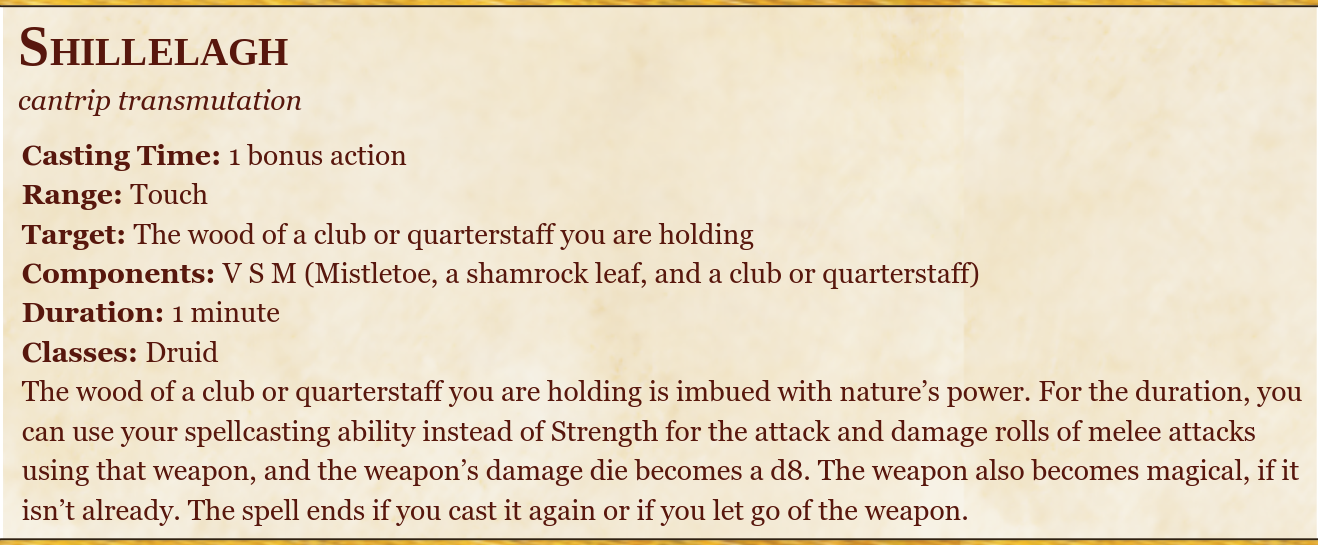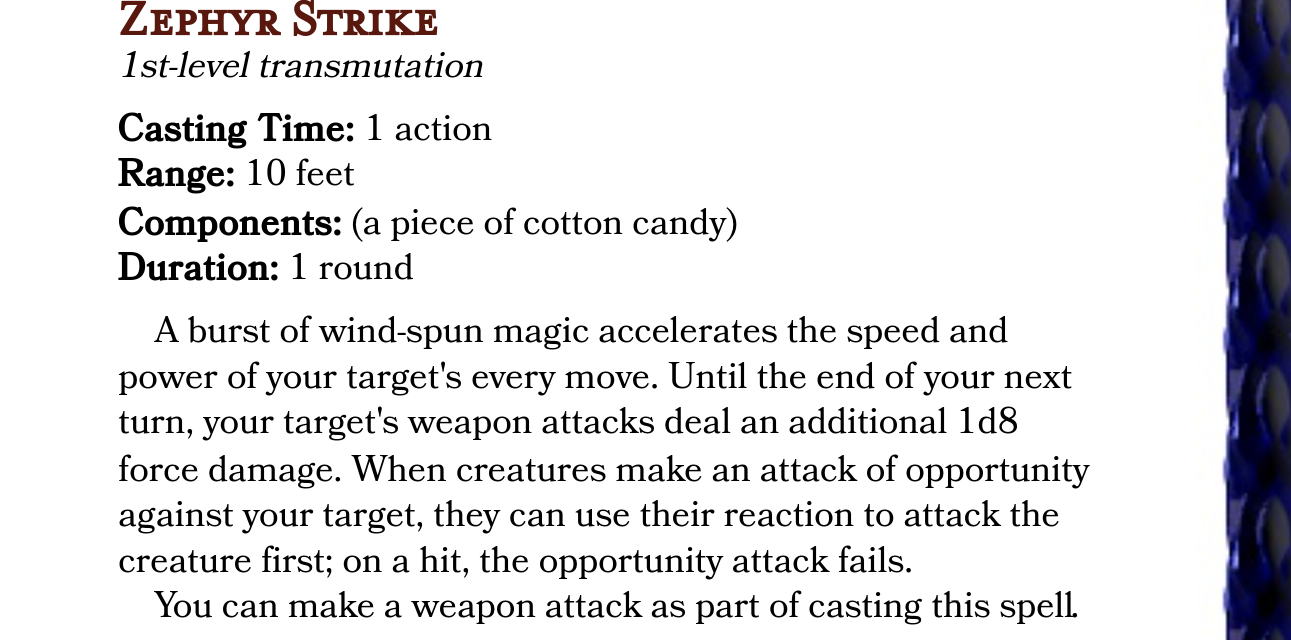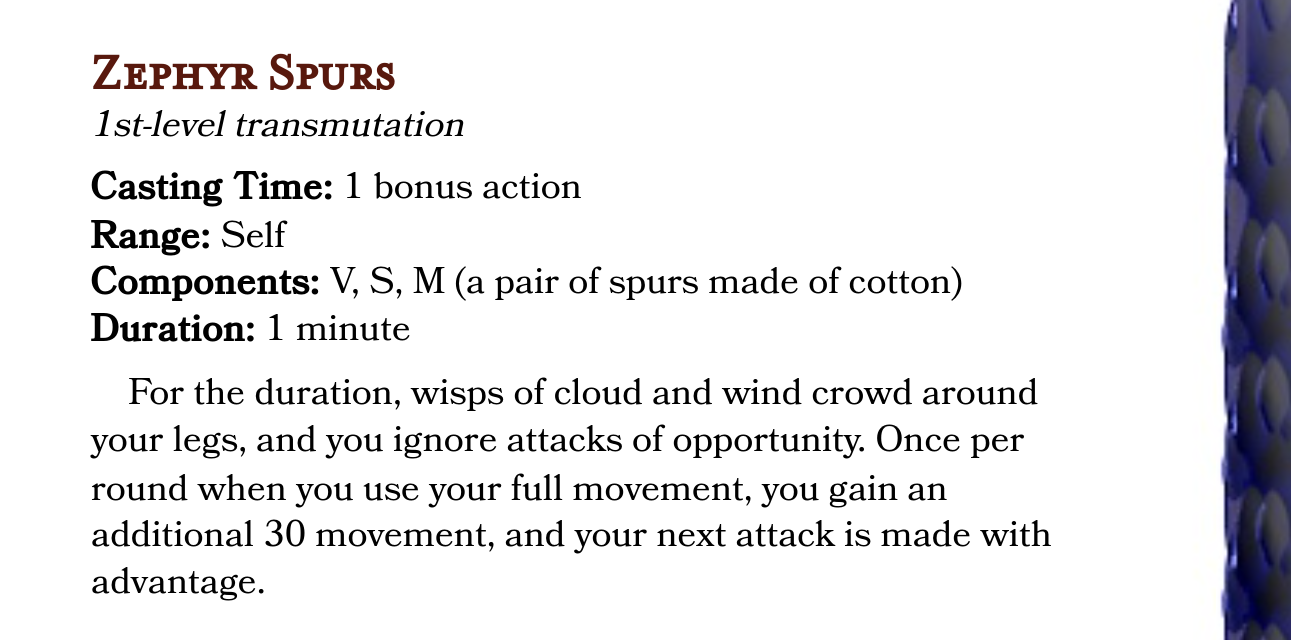I’m enjoying redesigning spells for 5th edition, as I can make this a daily post, maybe put it on dtrpg (after uploading the whole catelogue here for free), and solidify my own thoughts on magic design.
First on the chopping block is beast bond, an atrocity emblematic of how bad Wizards of the Coast is at doing anything, but especially spells.
Here’s the original text of beast bond:
Beast Bond
1st Level Transmutation
Casting time: 1 action
Range: Touch
Components: V, S, M
Duration: 10 minutes (Concentration)
You establish a telepathic link with one beast you touch that is friendly to you or charmed by you. The spell fails if the beast’s Intelligence is 4 or higher. Until the spell ends, the link is active while you and the beast are within line of sight of each other. Through the link, the beast can understand your telepathic messages to it, and it can telepathically communicate simple emotions and concepts back to you. While the link is active, the beast gains advantage on attack rolls against any creature within 5 feet of you that you can see.
This is worded quite miserably, so let’s separate the spell into benefits and conditions:
You gain telepathy with a beast:
You also grant the beast advantage on attack rolls:
Provided their Int score is 3 or lower (and you have no means of changing this).
Provided they’re attacking a creature within 5 feet of you.
Provided they’re within 30 feet of you.
Provided you can see them.
Provided you can see the target of their attack.
Most impressive, they chose to put this embarrassing block of text in the Elemental Evil’s player companion (and later reappeared in Xanathar’s Guide to Everything. I figured they would’ve given themselves and excuse and placed it in the player’s handbook. First time designing spells guys, you know how it is! Try not to be mad! Didn’t even give themselves some leeway!
So, why does this suck?
You can rarely even cast the spell.
In order for the spell to succeed, it must be cast on:
As it turns out, the list of creatures with these intersecting qualities is tiny. It includes fan favorites such as the mighty octopus, the boar, the owl, the riding horse. Hey, riding horse isn’t so bad. Panthers, wolves, poisonous snakes, and lions all have 3 or less, meaning they’re at an important spot in an upcomming venn diagram.
There’s a few precious higher level beasts as well; giant scorpions, mammoths, t-rexes, allosauruses, orcas, etc. I’ve grouped these examples (which take up the majority of the 5e eligible critters, mind you) intentionally. See, we first have eligible creatures which the players can easily come across in their travels, but can’t be used to fight. Well you theoretically can use the octopus to fight. It’s a bad idea, though. What’s it going to do? It’s an octopus! Even if you think of a clever idea, is advantage on attack rolls going to make or break whether our beloved cephalopod succeeds? Frankly I’m offended it’s even eligible for this spell, it should have a way higher intelligence.
I’ll skip to the big critters next. Orcas, mammoths, and t-rexes. Have a lot of t-rexes for sale in your campaign? No? How about orcas? Sea World keeping the market cornered, huh? Ca we give mammoths a-tropical campaign, alright that sounds like a no. If you do come across these critters, they’re combat encounters in 5th edition. Combat. That’s why they’re so high level. 5e doesn’t have taming mechanics. You’re allowed to have a pet if you choose a specific subclass of a specific class in 5e, and it’s not allowed to get better. There are a few player options made available since which let you get way cooler pets, but they’re limited to things other than beasts. No t-rexes. These creatures can be used to fight, but can’t be encountered frequently.
There are some spells which let you pick up animals as friends. Theoretically, your druid buddy could cast some of these to acquire one of these guys, temporarily. After that, you could give them advantage on attack rolls for 10 minutes, provided you kept a ready supply of enemies within 5 feet of you. And succeed on all of your concentration checks, because it’s a concentration spell, because WOTC hates you.
Hates you.
That’s why you need a separate friend in your party to turn these higher level combat encounters friendly for you, by the way. If you’re planning on using beast bond, you can’t be on taming duty. So, we’ve safely eliminated higher level creatures as a use case for this 1st level spell, along with the 0 level/CR critters which make up the vast majority of eligible critters. This brings us to our last group of critters.
We finally come to the small list of beasts on our already tiny list of creatures eligible for the spell’s effects which can potentially appear with frequency, and can in fact be used to fight. The reason being, the beastmaster ranger can pick these critters as their animal companion. If you don’t have a beastmaster in the party, these creatures no longer show up with any degree of frequency, and get relegated to the same class of critters which can fight but can’t be encountered often enough to justify taking the spell.
Given the frequency issue, I could’ve based this entire series of thoughts on the spell’s utility to the beastmaster archetype of the ranger alone, since it’s the only character option for whom this spell is even remotely usable. Indeed, many of the restrictions on the spell (which take up more text than the benefits) appear to be made with preventing the beastmaster from using this on their pets too often. So, who is the beastmaster picking for a pet? Well, turns out lions actually exceed the CR requirement of beastmaster pets, so they go with the mammoths and orcas. We’re left with panthers, poisonous snakes, and wolves. My my, what a list! WOTC sure put a lot of work into a 98 word spell just to make it relevant to 3 creatures. Panthers are a pretty good critter to cast this on, all things considered. They can pounce if they move in a 20 foot straight line, which can potentially knock an enemy prone. They have a 50 ft movement speed, meaning they can run back and forth 20 feet if you really want them too. They’ll even stay in range of the spell the entire time. Advantage is great for these guys.
How about poisonous snakes? Well, these guys tend to have crappy hitpoints, so they’re not the most impressive frontline fighters, but beastmasters give them a fighting chance thanks to a measly replacement of 4 x the ranger’s level in hitpoints. Wonderful. With advantage on attacks, the snake has a better chance of hitting and potentially inflicting some decent poison damage on the target. Lovely, two good creatures for an entire spell.
Oh wait! I forgot wolves. Wolves….have pack tactics.
Pack Tactics. The (creature) has advantage on an attack roll against a(n enemy) if at least one of the (creature)’s allies is within 5 feet of the (enemy) and the ally isn't incapacitated.
The effect of this spell. But always on. For free. Just for having it there. Without a spell.
Thanks, Wizards of the Coast. A whole first level spell with a whole list of 2 creatures one character archetype can maybe use this on if they don’t feel like casting hunter’s mark, assuming they were somehow tricked into playing this notoriously bad archetype by some less-than well meaning friends.
My Version (Better)
























































